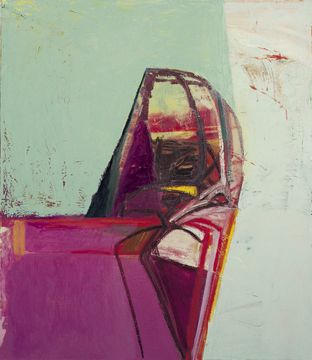
Amy Sillman, Untitled (object on table), 2007; courtesy the artist and Sikkema Jenkins & Co., New York
One of the students in my advanced classes is taking on the theme of “looking vs. seeing” for her first semester portfolio. She wants to explore the things people tend to overlook (or under-see) and over the next four months will create about a dozen works of art that explore the theme from different angles:
- What does it mean to see something?
- How is looking different from seeing?
- When you really see something, how do you know?
And this is just one of the many outstanding themes students are exploring. Others include:
- Picturing sound
- The relationship between drawing and photography
- Fear
- Beauty and youth
- Fairy tales and false promises
I even have one student who wants to explore, visually, particularly elusive phrases connected by the word “and” (such as “body and soul”).
Asking students to not only work thematically, but to work thematically in a series allows for the kind of immersion that most teachers dream about. Testing, unfortunately, has many of these teachers flitting from topic to topic trying to “cover a curriculum” that will surface on some standardized test vs. making space for students to become invested in exploring a theme and the big questions that go with it.
But getting to a theme that a student really wants to explore is perhaps the hardest hill to climb. Prior to choosing themes in the fall semester, I asked students to do a LOT of sketching as well as research into artists that have similar passions, ideas, or approaches to making art. We did a lot of exploring and talking about what makes us particularly happy, angry, confused and excited. We made lots of lists and notes. In just two weeks I have shared the “portfolios” of artists such as Eleanor Antin, Marilyn Minter, Ed and Nancy Kienholz, Amy Sillman, Sally Mann, Cindy Sherman and Barry McGee, to name a few.
In order to visualize working in a series, students need to see artists that not only work this way but think this way. Artists that do this especially well, and I am sure to bring into the classroom soon, include Dana Schutz (who happens to have a great show at the Neuberger Museum right now), Mark Rothko, Diego Rivera, Carrie Mae Weems, Yinka Shonibare MBE, Trenton Doyle Hancock, Nancy Spero, Collier Schorr, Rineke Dijkstra, William Eggleston, Robert Mangold and Mary Heilmann. Too often, students expect to generate great ideas by staring at a blank piece of paper and waiting for lightning. Instead, I encourage them to visually “wander” in order to compare the ideas they have with other artists, or compare the approaches and processes that some artists use with their own in order to inform their work… and ultimately inform the series.
How many of you get the opportunity to work with students on developing a body of work around a theme? What are your experiences? Are there other artists you use to illustrate working in a series? Share your stories with us!




Pingback: Teaching with Contemporary Art Turns Four | Art21 Blog